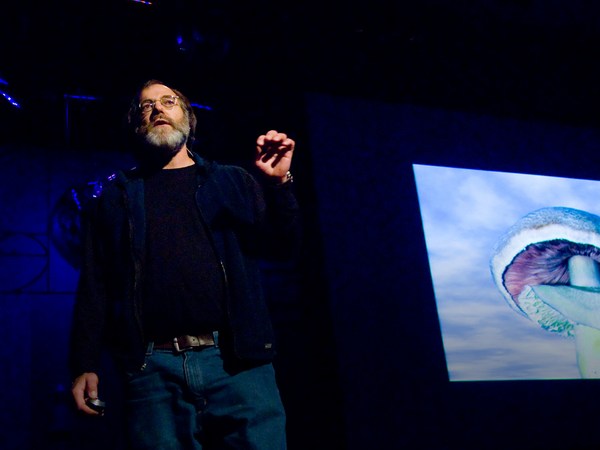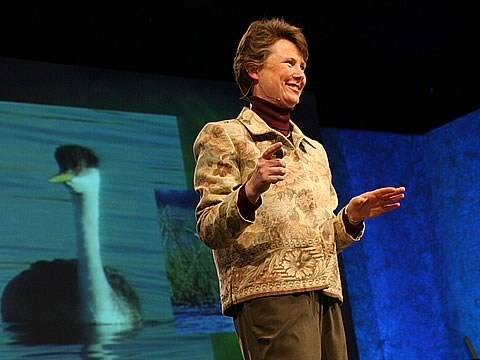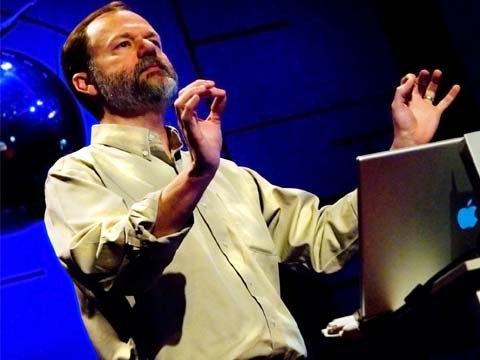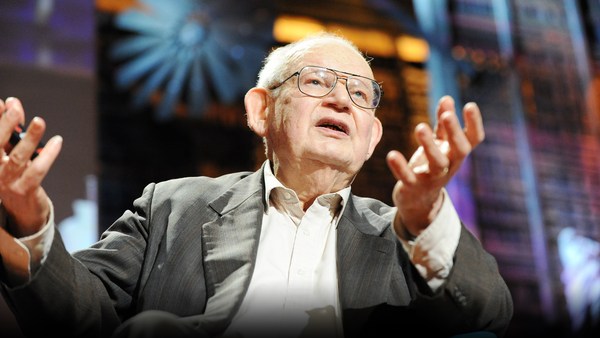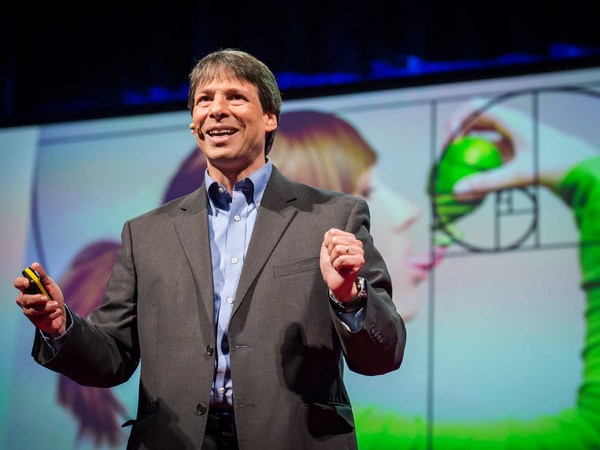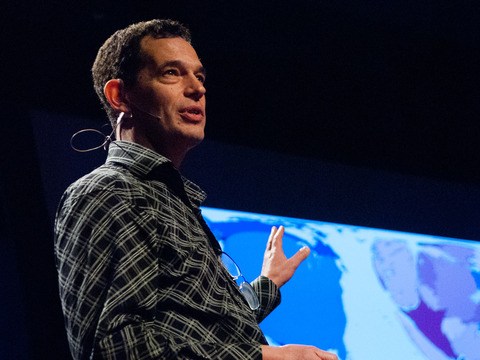I want to start my story in Germany, in 1877, with a mathematician named Georg Cantor. And Cantor decided he was going to take a line and erase the middle third of the line, and then take those two resulting lines and bring them back into the same process, a recursive process. So he starts out with one line, and then two, and then four, and then 16, and so on. And if he does this an infinite number of times, which you can do in mathematics, he ends up with an infinite number of lines, each of which has an infinite number of points in it. So he realized he had a set whose number of elements was larger than infinity. And this blew his mind. Literally. He checked into a sanitarium. (Laughter) And when he came out of the sanitarium, he was convinced that he had been put on earth to found transfinite set theory because the largest set of infinity would be God Himself. He was a very religious man. He was a mathematician on a mission.
And other mathematicians did the same sort of thing. A Swedish mathematician, von Koch, decided that instead of subtracting lines, he would add them. And so he came up with this beautiful curve. And there's no particular reason why we have to start with this seed shape; we can use any seed shape we like. And I'll rearrange this and I'll stick this somewhere -- down there, OK -- and now upon iteration, that seed shape sort of unfolds into a very different looking structure. So these all have the property of self-similarity: the part looks like the whole. It's the same pattern at many different scales.
Now, mathematicians thought this was very strange because as you shrink a ruler down, you measure a longer and longer length. And since they went through the iterations an infinite number of times, as the ruler shrinks down to infinity, the length goes to infinity. This made no sense at all, so they consigned these curves to the back of the math books. They said these are pathological curves, and we don't have to discuss them. (Laughter) And that worked for a hundred years.
And then in 1977, Benoit Mandelbrot, a French mathematician, realized that if you do computer graphics and used these shapes he called fractals, you get the shapes of nature. You get the human lungs, you get acacia trees, you get ferns, you get these beautiful natural forms. If you take your thumb and your index finger and look right where they meet -- go ahead and do that now -- -- and relax your hand, you'll see a crinkle, and then a wrinkle within the crinkle, and a crinkle within the wrinkle. Right? Your body is covered with fractals. The mathematicians who were saying these were pathologically useless shapes? They were breathing those words with fractal lungs. It's very ironic. And I'll show you a little natural recursion here. Again, we just take these lines and recursively replace them with the whole shape. So here's the second iteration, and the third, fourth and so on.
So nature has this self-similar structure. Nature uses self-organizing systems. Now in the 1980s, I happened to notice that if you look at an aerial photograph of an African village, you see fractals. And I thought, "This is fabulous! I wonder why?" And of course I had to go to Africa and ask folks why. So I got a Fulbright scholarship to just travel around Africa for a year asking people why they were building fractals, which is a great job if you can get it. (Laughter)
And so I finally got to this city, and I'd done a little fractal model for the city just to see how it would sort of unfold -- but when I got there, I got to the palace of the chief, and my French is not very good; I said something like, "I am a mathematician and I would like to stand on your roof." But he was really cool about it, and he took me up there, and we talked about fractals. And he said, "Oh yeah, yeah! We knew about a rectangle within a rectangle, we know all about that." And it turns out the royal insignia has a rectangle within a rectangle within a rectangle, and the path through that palace is actually this spiral here. And as you go through the path, you have to get more and more polite. So they're mapping the social scaling onto the geometric scaling; it's a conscious pattern. It is not unconscious like a termite mound fractal.
This is a village in southern Zambia. The Ba-ila built this village about 400 meters in diameter. You have a huge ring. The rings that represent the family enclosures get larger and larger as you go towards the back, and then you have the chief's ring here towards the back and then the chief's immediate family in that ring. So here's a little fractal model for it. Here's one house with the sacred altar, here's the house of houses, the family enclosure, with the humans here where the sacred altar would be, and then here's the village as a whole -- a ring of ring of rings with the chief's extended family here, the chief's immediate family here, and here there's a tiny village only this big. Now you might wonder, how can people fit in a tiny village only this big? That's because they're spirit people. It's the ancestors. And of course the spirit people have a little miniature village in their village, right? So it's just like Georg Cantor said, the recursion continues forever.
This is in the Mandara mountains, near the Nigerian border in Cameroon, Mokoulek. I saw this diagram drawn by a French architect, and I thought, "Wow! What a beautiful fractal!" So I tried to come up with a seed shape, which, upon iteration, would unfold into this thing. I came up with this structure here. Let's see, first iteration, second, third, fourth. Now, after I did the simulation, I realized the whole village kind of spirals around, just like this, and here's that replicating line -- a self-replicating line that unfolds into the fractal. Well, I noticed that line is about where the only square building in the village is at. So, when I got to the village, I said, "Can you take me to the square building? I think something's going on there." And they said, "Well, we can take you there, but you can't go inside because that's the sacred altar, where we do sacrifices every year to keep up those annual cycles of fertility for the fields." And I started to realize that the cycles of fertility were just like the recursive cycles in the geometric algorithm that builds this. And the recursion in some of these villages continues down into very tiny scales.
So here's a Nankani village in Mali. And you can see, you go inside the family enclosure -- you go inside and here's pots in the fireplace, stacked recursively. Here's calabashes that Issa was just showing us, and they're stacked recursively. Now, the tiniest calabash in here keeps the woman's soul. And when she dies, they have a ceremony where they break this stack called the zalanga and her soul goes off to eternity. Once again, infinity is important.
Now, you might ask yourself three questions at this point. Aren't these scaling patterns just universal to all indigenous architecture? And that was actually my original hypothesis. When I first saw those African fractals, I thought, "Wow, so any indigenous group that doesn't have a state society, that sort of hierarchy, must have a kind of bottom-up architecture." But that turns out not to be true.
I started collecting aerial photographs of Native American and South Pacific architecture; only the African ones were fractal. And if you think about it, all these different societies have different geometric design themes that they use. So Native Americans use a combination of circular symmetry and fourfold symmetry. You can see on the pottery and the baskets. Here's an aerial photograph of one of the Anasazi ruins; you can see it's circular at the largest scale, but it's rectangular at the smaller scale, right? It is not the same pattern at two different scales.
Second, you might ask, "Well, Dr. Eglash, aren't you ignoring the diversity of African cultures?" And three times, the answer is no. First of all, I agree with Mudimbe's wonderful book, "The Invention of Africa," that Africa is an artificial invention of first colonialism, and then oppositional movements. No, because a widely shared design practice doesn't necessarily give you a unity of culture -- and it definitely is not "in the DNA." And finally, the fractals have self-similarity -- so they're similar to themselves, but they're not necessarily similar to each other -- you see very different uses for fractals. It's a shared technology in Africa.
And finally, well, isn't this just intuition? It's not really mathematical knowledge. Africans can't possibly really be using fractal geometry, right? It wasn't invented until the 1970s. Well, it's true that some African fractals are, as far as I'm concerned, just pure intuition. So some of these things, I'd wander around the streets of Dakar asking people, "What's the algorithm? What's the rule for making this?" and they'd say, "Well, we just make it that way because it looks pretty, stupid." (Laughter) But sometimes, that's not the case. In some cases, there would actually be algorithms, and very sophisticated algorithms. So in Manghetu sculpture, you'd see this recursive geometry. In Ethiopian crosses, you see this wonderful unfolding of the shape.
In Angola, the Chokwe people draw lines in the sand, and it's what the German mathematician Euler called a graph; we now call it an Eulerian path -- you can never lift your stylus from the surface and you can never go over the same line twice. But they do it recursively, and they do it with an age-grade system, so the little kids learn this one, and then the older kids learn this one, then the next age-grade initiation, you learn this one. And with each iteration of that algorithm, you learn the iterations of the myth. You learn the next level of knowledge.
And finally, all over Africa, you see this board game. It's called Owari in Ghana, where I studied it; it's called Mancala here on the East Coast, Bao in Kenya, Sogo elsewhere. Well, you see self-organizing patterns that spontaneously occur in this board game. And the folks in Ghana knew about these self-organizing patterns and would use them strategically. So this is very conscious knowledge.
Here's a wonderful fractal. Anywhere you go in the Sahel, you'll see this windscreen. And of course fences around the world are all Cartesian, all strictly linear. But here in Africa, you've got these nonlinear scaling fences. So I tracked down one of the folks who makes these things, this guy in Mali just outside of Bamako, and I asked him, "How come you're making fractal fences? Because nobody else is." And his answer was very interesting. He said, "Well, if I lived in the jungle, I would only use the long rows of straw because they're very quick and they're very cheap. It doesn't take much time, doesn't take much straw." He said, "but wind and dust goes through pretty easily. Now, the tight rows up at the very top, they really hold out the wind and dust. But it takes a lot of time, and it takes a lot of straw because they're really tight." "Now," he said, "we know from experience that the farther up from the ground you go, the stronger the wind blows." Right? It's just like a cost-benefit analysis. And I measured out the lengths of straw, put it on a log-log plot, got the scaling exponent, and it almost exactly matches the scaling exponent for the relationship between wind speed and height in the wind engineering handbook. So these guys are right on target for a practical use of scaling technology.
The most complex example of an algorithmic approach to fractals that I found was actually not in geometry, it was in a symbolic code, and this was Bamana sand divination. And the same divination system is found all over Africa. You can find it on the East Coast as well as the West Coast, and often the symbols are very well preserved, so each of these symbols has four bits -- it's a four-bit binary word -- you draw these lines in the sand randomly, and then you count off, and if it's an odd number, you put down one stroke, and if it's an even number, you put down two strokes. And they did this very rapidly, and I couldn't understand where they were getting -- they only did the randomness four times -- I couldn't understand where they were getting the other 12 symbols. And they wouldn't tell me. They said, "No, no, I can't tell you about this." And I said, "Well look, I'll pay you, you can be my teacher, and I'll come each day and pay you." They said, "It's not a matter of money. This is a religious matter."
And finally, out of desperation, I said, "Well, let me explain Georg Cantor in 1877." And I started explaining why I was there in Africa, and they got very excited when they saw the Cantor set. And one of them said, "Come here. I think I can help you out here." And so he took me through the initiation ritual for a Bamana priest. And of course, I was only interested in the math, so the whole time, he kept shaking his head going, "You know, I didn't learn it this way." But I had to sleep with a kola nut next to my bed, buried in sand, and give seven coins to seven lepers and so on. And finally, he revealed the truth of the matter. And it turns out it's a pseudo-random number generator using deterministic chaos. When you have a four-bit symbol, you then put it together with another one sideways. So even plus odd gives you odd. Odd plus even gives you odd. Even plus even gives you even. Odd plus odd gives you even. It's addition modulo 2, just like in the parity bit check on your computer. And then you take this symbol, and you put it back in so it's a self-generating diversity of symbols. They're truly using a kind of deterministic chaos in doing this. Now, because it's a binary code, you can actually implement this in hardware -- what a fantastic teaching tool that should be in African engineering schools.
And the most interesting thing I found out about it was historical. In the 12th century, Hugo of Santalla brought it from Islamic mystics into Spain. And there it entered into the alchemy community as geomancy: divination through the earth. This is a geomantic chart drawn for King Richard II in 1390. Leibniz, the German mathematician, talked about geomancy in his dissertation called "De Combinatoria." And he said, "Well, instead of using one stroke and two strokes, let's use a one and a zero, and we can count by powers of two." Right? Ones and zeros, the binary code. George Boole took Leibniz's binary code and created Boolean algebra, and John von Neumann took Boolean algebra and created the digital computer. So all these little PDAs and laptops -- every digital circuit in the world -- started in Africa. And I know Brian Eno says there's not enough Africa in computers, but you know, I don't think there's enough African history in Brian Eno. (Laughter) (Applause)
So let me end with just a few words about applications that we've found for this. And you can go to our website, the applets are all free; they just run in the browser. Anybody in the world can use them. The National Science Foundation's Broadening Participation in Computing program recently awarded us a grant to make a programmable version of these design tools, so hopefully in three years, anybody'll be able to go on the Web and create their own simulations and their own artifacts. We've focused in the U.S. on African-American students as well as Native American and Latino. We've found statistically significant improvement with children using this software in a mathematics class in comparison with a control group that did not have the software. So it's really very successful teaching children that they have a heritage that's about mathematics, that it's not just about singing and dancing. We've started a pilot program in Ghana. We got a small seed grant, just to see if folks would be willing to work with us on this; we're very excited about the future possibilities for that.
We've also been working in design. I didn't put his name up here -- my colleague, Kerry, in Kenya, has come up with this great idea for using fractal structure for postal address in villages that have fractal structure, because if you try to impose a grid structure postal system on a fractal village, it doesn't quite fit. Bernard Tschumi at Columbia University has finished using this in a design for a museum of African art. David Hughes at Ohio State University has written a primer on Afrocentric architecture in which he's used some of these fractal structures.
And finally, I just wanted to point out that this idea of self-organization, as we heard earlier, it's in the brain. It's in the -- it's in Google's search engine. Actually, the reason that Google was such a success is because they were the first ones to take advantage of the self-organizing properties of the web. It's in ecological sustainability. It's in the developmental power of entrepreneurship, the ethical power of democracy. It's also in some bad things. Self-organization is why the AIDS virus is spreading so fast. And if you don't think that capitalism, which is self-organizing, can have destructive effects, you haven't opened your eyes enough. So we need to think about, as was spoken earlier, the traditional African methods for doing self-organization. These are robust algorithms. These are ways of doing self-organization -- of doing entrepreneurship -- that are gentle, that are egalitarian. So if we want to find a better way of doing that kind of work, we need look only no farther than Africa to find these robust self-organizing algorithms. Thank you.
